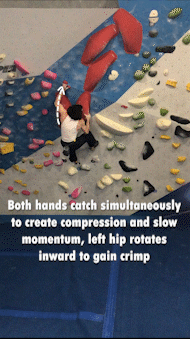Breakdown
Climber: Eddie Pandolfino 6’0”/-2
Wall Angle: 10° Overhang>Flat
Holds: Cheeta BoomJumps, Flathold Damage Control Jibs, Urban Plastix Stealth Crimps
RIC: Risk 4, Intensity 3, Complexity 3
This boulder is broken up into two sections that present different types of risk. The first all points off dyno challenges the climber with generating, coordinating, and controlling momentum. There is a high chance of failure if one of these attributes is not gauged correctly. The second section presents slower, tense movement on small footholds. If weight is not shifted correctly it is easy to lose balance or slip because of the amount of weight being driven through the feet. Intensity is present because of the high shoulder and bicep engagement required throughout the climb. Complexity comes in the form of nuance. There are small body positioning adjustments that are key to maintaining balance. If these are missed the boulder becomes much harder.
Influence/Aesthetic:
Most of the inspiration for this boulder came from a movement perspective. The original iteration of this boulder was reset, but it also involved a coordination movement into slower more technical climbing. I have been playing around recently with using combinations of large macro features and some exceptionally small micro screw-ons as complimentary feet and hands. I think this can help balance out the visual composition of a boulder if done correctly. Here I wasn’t quite satisfied with how it turned out. The biggest issue is the large empty space at the bottom of the boulder. This creates less of a coherent aesthetic which could be fixed by one or two larger holds at the start as feet. However, I felt that functionally the smaller start hands and feet made the first dyno feel appropriate for the difficulty and created a proper “flow” for the move. The top of the boulder is tied together a bit better with the large fiberglass features stemming out of each other and the small stacks of crimps and feet accentuating the angle change of the wall.
Hold Selection:
Choosing holds for any dynamic move is often a dealbreaker for success. The Cheeta BoomJumps are especially useful because they are positive but have clean, sloped surface areas. This puts more of an emphasis on open-hand grip rather than crimping. This often makes them difficult to control unless the climber’s body is positioned correctly. All of the holds have an emphasis on directionality to manipulate the climber’s body position to complement the direction. The addition of smaller footholds also encourages the climber to accurately place their feet as readjusting can be difficult.
Point Break
The climber begins by creating shoulder engagement through the opposing start holds.
Bending the knees outward while sinking into the hips and shoulders gives the climber space to create momentum as they stand up.
Once the climber’s legs reach full extension the hands release as the body moves upward. The next two holds are grabbed simultaneously to compress and create shoulder engagement.
Driving the left hip inward closes the distance to the next left-hand crimp.
Light on the Toes
The climber smears the wall to create a higher point of opposition against the left hand. This allows the right foot to raise to the far right foot jib.
Pulling over the right foot places the climber’s hips beneath the next fiberglass hold.
Opposition is created between the right hand and right foot. A slight left back flag lets the bicep fully contract to release weight from the left hand.
The left hand comes up to gain the next fiberglass undercling, increasing pressure against the right foot.
Technical and Tense
The climber begins to step their right foot upward to assist in matching the penultimate hold. The left foot is brought up a second time to create a squared base to shift their hips rightward.
While utilizing a gaston on the finish, the climber straightens their left leg to improve shoulder engagement and opposition to match the finish.
Final Thoughts
As I have mentioned previously, this was not the first iteration of this boulder. I completely stripped the initial version of this climb during our first day of setting this zone. It’s always a tough feeling stripping a boulder, especially when you are the chief of the crew. Frustration, failure, and disappointment are only a few of the emotions I run through when this happens. However, I think walking away from things that aren’t working may seem like “giving up” but I have found this isn’t always the case. Everyone’s boulders contribute to the quality of a set. If scrapping one will improve the flow of forerunning and allow time to be distributed better to the other boulders, it is the right move. I’m still learning the most constructive way to work through these situations but looking back on them has given me some valuable insights for the future.



